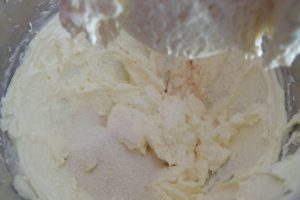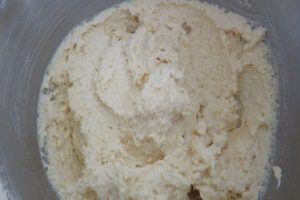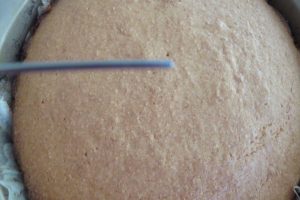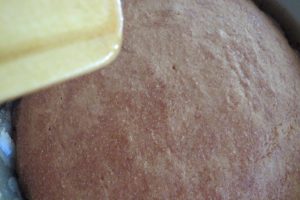Greek Semolina Cake is a moist cake mixed with semolina and desiccated coconut that is drizzled with lemon syrup. This dessert is a crowd-pleaser and will have guests coming back for seconds!
Ahh.. the Mediterranean diet! Not only does it conjure images of resorts by the Mediterranean Sea, but it is also advertised as the healthiest diet in the world. Ranging from the addition of extra virgin olive oil to mostly seafood or vegetarian options makes the Mediterranean diet both nutritious and delectable. Several studies have proven that the Mediterranean diet reduces bad cholesterol, improves heart health, and optimizes blood sugar levels. I think that most epicures who have tried Greek food would be nodding when I say that there is a charm in making Greek food.
None of this is more important than when it is time to have dessert. Traditionally, desserts are made up of refined carbs and added sugars, which is not what the Mediterranean diet extols. So how do we, and excuse the pun, have our cake and eat it too?
What is semolina?
Semolina is a coarse, ground durum wheat flour. It is rich in protein, fiber, and B vitamins and supports weight loss, heart health, and digestion, while also improving blood sugar levels. While semolina is gluten rich, there are alternatives, as I have indicated below if you are allergic or prefer gluten-free options.
Revani or Ravani:
This Greek dessert sponge cake is called revani or ravani, ostensibly named for the Turkish poet, Ravani, who inspired this cake. Greek Semolina Cake is traditionally made on festive occasions in Greece. That said, there are variations of this cake all over the Middle East called Basbousa.
This recipe is a sponge cake made with semolina and coconut and is showered generously with lemon syrup. While you can use orange syrup as an alternative, I favor the fresh citrusy flavor of lemons as a tart counterpoint to this sweet, dreamy marriage between coconut and semolina. One bite into this cake will create an explosion due to the complex interplay between the ingredients and a nice mouth feel because of the structure provided by both semolina and coconut.
Greek Semolina Cake is a both a baker and a crowd-pleaser. It provides a healthy alternative to richer desserts and takes less time to make as compared to most other desserts and has a relatively long shelf life. All I have to do is combine the ingredients and let the electric mixer do the rest, while I prepare the syrup on the side.
Variations of the Greek Semolina Cake:
I like this particular method of making the semolina cake. Variations that I have tried include making it without the coconut or soaking in sugar syrup after baking. This tends to make the cake overly sweet and negates the health benefits. This recipe is an adaptation of a recipe given to me by the mother of one of our Greek friends. She baked this cake at home and flew it with her in an airtight container when she was visiting her daughter, who was a student at Bristol, UK.
Her recipe, of which I had second and third servings, was richer than the version below. She adorned her cake with dried peaches and apricots and was extremely moist, indicating that she had copiously used her lemon syrup. The lemon syrup moistened an otherwise dry cake, but also acted as a preservative for its relatively long journey.
I changed both the toppings, preferring sugared lemon slices (which would have otherwise gone to a waste) and reduced the lemon syrup primarily because my family does not like it too sweet or overly moist. The amount of sugar I used in the cake seems “just right”. I have used this cake as a base for birthday cakes for my children. It is a sturdy cake if you do not add much syrup to it. You can add fresh fruit or even citrusy berries to add some complexity to the flavor.
As I said, this cake is an Eastern Mediterranean dessert that will compliment pretty much any Greek and most Middle Eastern dishes. Slice the cake however you like. It will look quite enticing on the dessert table. Check out my other Continental baked goods such as the Ground Hazelnut Cookies and Swiss Tarts if you are craving for something sweet!

How to make Greek Semolina Cake:
- How to make the semolina cake:
- How to make the lemon syrup:
1. How to make the semolina cake:
- Preheat oven to 350degrees F. Grease a 9″ round pan with melted butter and line with wax paper. Beat the butter and sugar until light and fluffy for about 11 minutes.

- Whisk the eggs with a fork in a small bowl.

- Gradually, add the eggs, beating well between each addition.

- Add the vanilla extract and semolina and beat for 6 minutes.

- Fold in the desiccated coconut and self-rising flour and stir until combined.

- Spoon the batter into the prepared cake pan. Smoothen the top with a palette knife.

- Bake for 40 minutes or until skewer comes out clean.

- Drizzle the lemon syrup evenly on the hot cake. Serve chilled garnished with the lemon slices from the lemon syrup.

2. How to make the lemon syrup:
- Combine the water and sugar over low heat and stir until dissolved.

- Add the lemon slices and simmer uncovered for 16 minutes without stirring. Drizzle the lemon syrup on the cake and garnish with the lemon slices.

1. Could olive oil be used instead of the butter? Some variations of this cake calls for olive oil. I believe that the idea is to make the dessert a slightly healthier option.
2. What are the other toppings that can be used? Some cooks have used fresh fruits like peaches or even melons in some cases. Watermelon slices on the cake might add sweetness and moisture although I have not tried it.
Gluten-free option:
For those of you who prefer gluten free, you can substitute semolina with almond flour for half the quantity of the plain flour. These were all extremely delicious variations of a cake that you are bound to finish within a day or two!
How to store the Greek Semolina Cake:
The Greek Semolina Cake can be refrigerated in an airtight box for a week with or without the syrup. You can freeze the cake for a couple of months in a freezer box. Add the freshly prepared lemon syrup on the day of serving it, after thawing the cake to room temperature.
Greek Semolina Cake
Equipment
- stand mixer, oven
Ingredients
For the Greek Semolina Cake:
- 8 ozs unsalted butter
- 1 cup granulated sugar
- 3 eggs lightly beaten
- 1 cup semolina fine
- 1 tsp vanilla extract
- ¾ cup coconut shredded
- 1¼ cup self-rising flour
For the lemon syrup:
- ¾ cup granulated sugar
- 1 cup water
- 1 lemon thinly sliced
Instructions
How to make the Greek Semolina Cake:
- Preheat oven to 350 degrees F. Grease a 9" round pan with melted butter and line with wax paper. Beat the butter and sugar until light and fluffy for about 11 minutes.
- Lightly whisk the eggs in a small bowl using a fork.
- Gradually, add the eggs, beating well between each addition.
- Add the vanilla extract and semolina and beat for 6 minutes.
- Fold in the desiccated coconut and self-rising flour and stir until combined.
- Spoon the batter into the prepared cake pan. Smoothen the top with a palette knife.
- Bake for 40 minutes or until skewer comes out clean.
- Drizzle the lemon syrup evenly on the hot cake. Serve chilled garnished with the lemon slices from the lemon syrup.
Notes
Nutrition
























Hi Kanchan!
I made this at home for my kids and they absolutely loved it! Thanks for sharing!
the semolina is a great ingredient!